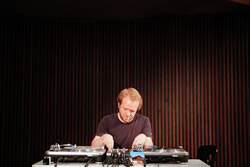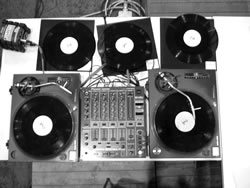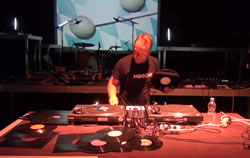The Tu(r)ning of the (W)o(r)ld
(Advant)age
The turntable as such has no genuine sound and so no historical load to carry on its back. At first sight.
But during the rehearsal of the graphically scored piece Wels, 21.10.11 for a concert at the Landesmusikschule Wels, when composer Christoph Herndler tells me that I should play a tune free of cliché, free of expressive gesture, I realize how “old”, limited and self-referential the instrument (turntable) itself has ended up being in “classical” instrumental formations; it has evolved from a meta-level to a first-level sound device.
Interna(tiona)l

The comment “Mr. or Mrs. XXX is playing turntable” doesn’t tell us much about what is going to be played or how, it just says that there is at least one record player on stage. By the way, in “new” and “experimental” settings, there’s also no guarantee that the audience will really see a cello or flute being played as it is usually taught at school or in the academy, nor a hint that the device is going to be physically touched during the concert. A wide field is opened here for the human actor or actress to meet or not to meet (the expectations of) the audience, the critics, the curator, the musician her / himself.
We see, after nearly half a century of eating and mashing up music history, that the record player is still in a state of being a fresh music machine / box.
No (re)cords
I love off-beat expressions like “rotating surfaces” (Ignaz Schick) or “no-record” record player (referring to the no-input mixing desk introduced by Toshimaru Nakamura) used to describe what’s going to happen on a technical layer and its impact on the musical layer and the — finally — projected sounds, and then the repercussion on æsthetic decisions etc. Similar to Nicolas Collins’ term “trombone-propelled electronics”, it clearly states that it’s about an extension of a traditional instrument and that the extension matters and makes a difference, that a chain of treatments / effects are applied to the dry signal. More than just a joke: sweet smoke.
Soundcheck

Nearly every time I’m finished with my stage setup (basically a “classic” DJ mixer accompanied by two standard turntables) and ask for a proper line check, there’s this expectation of the sound guy (rather than a sound lady) to test the system by feeding it with state-of-the-art electronica or — even better — “good” old R’N’R to deaf down everyone working in the room, like a reward for their good and cooperative behaviour. Same procedure as with masters on guitar, when they are forced and happy to finger up and down the neck of their electric dick. I feel treated like a limousine driver accidentally going off-road, who would be best to slide back to the official track to spare gear and (their) nerves. The way I really hate so-called SUVs conquering the streets in urban and flat regions and adding an enormous wall of sound to the realm of R. Murray Schafer’s tuned world (as referenced in the title of this essay), I love the idea of driving cross-country on the decks in lofi-style without being preached to caution. In spite of that, I have to confess: me as a listener is loving the “classical” scratch virtuoso, the “Phallus in Plunderland”.
Out in the Fields


If you really wanna draw a line between the diverse styles and subgenres of “turntablism” maybe start between groove-based and non-groove-based music. This attempt to classify such diverse approaches might seem to be as stupid as the focus on either the time or the spectral domain is narrow-minded. While beat matching is about big efforts to adjust the groove of two or more tracks on several vinyl records, musicians categorized as spectromorphologists are thinking about and hearing music slower, deeper and mainly from the other edge of the Fourier stream. But since every record-player player working with records puts her / his hands on the discs there’s of course one thing common to them all: on the decks you cannot separate the manipulation in time from the shift on the frequency meter (except for some very tricky vinyl work, for example by Florian Hecker, where one can hardly hear the impact of the turntable speed on the sound output due to unusual timbral and textural effects)!
Apart from this, I have always been wondering where groove as pattern starts and ends, which length of a loop or bar corresponds with the inner / outer logic of a given piece in my ears. If a single loop lasts for 2 minutes, is it still a loop in terms of Gilles Deleuze’s philosophy of difference and repetition? On the other end of the time stretcher, do short grains match with the groove that makes your booty move? Thanks to Bernhard Lang, I know: yes, they do!
Back to School
So I really like the idea / concept of being a curator, an organizer, an operator etc. of sound when playing the turntable. Sometimes the outer or physical skills in my work are on a quite modest level, the manipulation of the material used can hardly be heard. Since I tend to see “art” coming from context, the pre-selection, collecting and testing of “my” sounds is of equal importance to the sonic acting in a live or studio setting itself. The ability to switch between genres, styles, needles, textures, cymbals, styrofoam, locked grooves, dust… to be in a vague command of a big sonic world keeps me busy, prevents me from being bored, makes me laugh. I’m infant all of a sudden!

Social top